
takodje mozes pogledati arhivu da vidis prijasnje slike.
- http://apod.nasa.gov/apod/
Moforaja (http://moforaja.com/index.php)
- NAUKA I DRUŠTVO (http://moforaja.com/board.php?boardid=14)
-- NAUKA (http://moforaja.com/board.php?boardid=16)
--- NASA - foto dana (http://moforaja.com/threadid.php?threadid=14923)
NASA - foto dana
dakle svaki dan postavljaju novi slicicu. odlicno je 
takodje mozes pogledati arhivu da vidis prijasnje slike.
http://apod.nasa.gov/apod/
___________________________________________________________________
kad ce mostar mama?
evo par slicica iz arhive
Explanation: In 185 AD, Chinese astronomers recorded the appearance of a new star in the Nanmen asterism - a part of the sky identified with Alpha and Beta Centauri on modern star charts. The new star was visible for months and is thought to be the earliest recorded supernova. Data from two orbiting X-ray telescopes of the 21st century, XMM-Newton and Chandra, now offer evidence that supernova remnant RCW 86 is indeed the debris from that stellar explosion. Their composite, false-color view of RCW 86 shows the expanding shell of material glowing in x-rays with high, medium, and low energies shown in blue, green, and red hues. Shock velocities measured in the x-ray emitting shell and an estimated radius of about 50 light-years can be used to find the apparent age of the remnant. The results indicate that light from the initial explosion could well have first reached planet Earth in 185 AD. Near the plane of our Milky Way Galaxy, RCW 86 is about 8,200 light-years away.
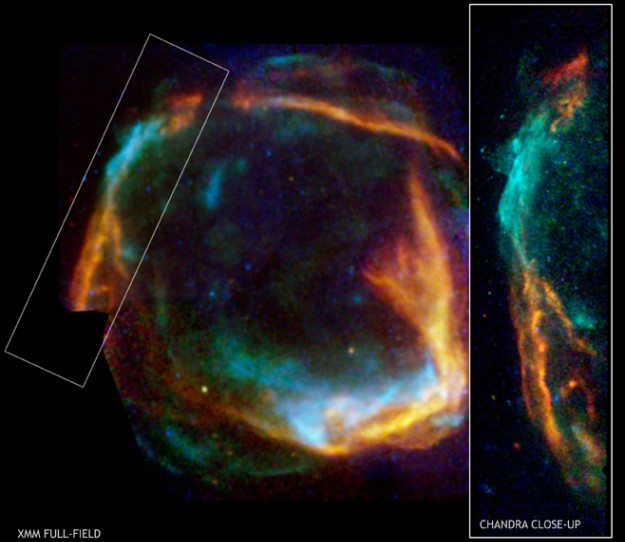
___________________________________________________________________
kad ce mostar mama?
Explanation: Fix your camera to a tripod, lock the shutter open, and you can make an image of star trails - graceful concentric arcs traced by the stars as planet Earth rotates on its axis. Of course, the length of the star trails will depend on the exposure time. While exposures lasting just five minutes produce a significant arc, in about 12 hours a given star would trace out half a circle. But in any long exposure, the background glow from light-polluted skies can build up to wash out the trails. Still, astronomer Josch Hambsch produced this stunning composite of star trails around the South Celestial Pole with an effective "all night" exposure time of almost 11 hours. To do it, he combined 128 consecutive five minute long digital exposures recorded in very dark night skies above Namibia. In his final image, the background glow on the right is due in part to the faint, arcing Milky Way.

___________________________________________________________________
kad ce mostar mama?
Explanation: When morning twilight came to the Paranal Observatory in Chile, astronomers Mark Neeser and Peter Barthel interrupted their search for faint quasars, billions of light-years away. And just for a moment, they used Very Large Telescopes at the European Southern Observatory to appreciate the beauty of the nearby Universe. One result was this stunning view of beautiful spiral galaxy M66, a mere 35 million light-years away. About 100 thousand light-years across with striking dust lanes and bright star clusters along sweeping spiral arms, M66 is well known to astronomers as a member of the Leo Triplet of galaxies. Gravitational interactions with its neighborhood galaxies have likely influenced the shape of dusty spiral M66.
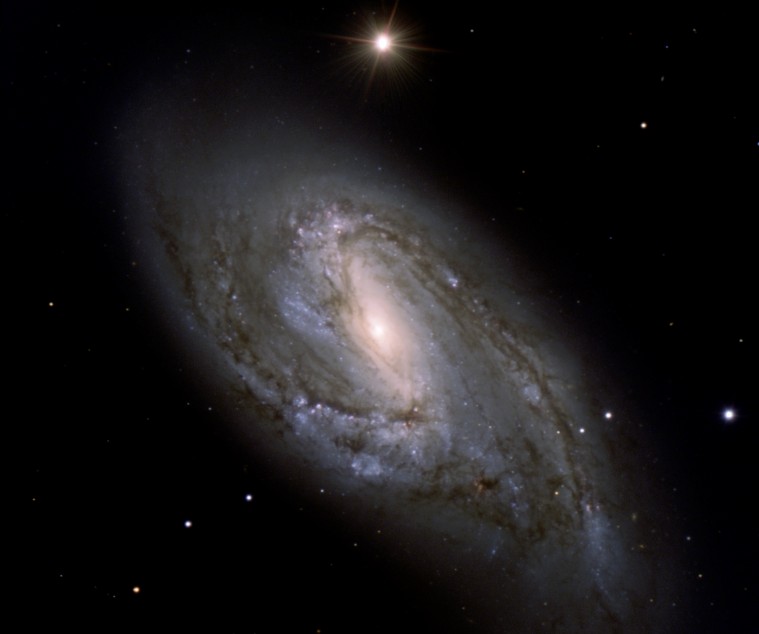
___________________________________________________________________
kad ce mostar mama?
Explanation: Stars come and go as you slide your cursor over this engaging image of M8, aka the Lagoon Nebula. Of course, the nebula is itself a star-forming region, but the stars that appear and disappear here include background and foreground stars that by chance lie along the same line of sight. In this "for fun" comparison of two nearly identical digital images, the stellar point sources were removed from one image by computer processing to leave only the diffuse emission from the glowing gas clouds. In both pictures, red emission (H-alpha emission) from atomic hydrogen dominates the cosmic lagoon's visible light, but narrow band filters were used to record the image data and map the hydrogen emission to green hues, with emission from sulfur atoms in red and oxygen in blue. The lovely Lagoon Nebula spans about 30 light-years at an estimated distance of 5,000 light-years toward the constellation Sagittarius.

___________________________________________________________________
kad ce mostar mama?
Explanation: Might it rain cold methane on Saturn's Titan? Recent analyses of measurements taken by the Huygen's probe that landed on Titan in 2005 January indicate that the atmosphere is actually saturated with methane at a height of about 8 kilometers. Combined with observations of a damp surface and lakes near the poles, some astrobiologists conclude that at least a methane drizzle is common on parts of Titan. Other astrobiologists reported computer models of the clouded moon that indicate that violent methane storms might even occur, complete with flash floods carving channels in the landscape. The later scenario is depicted in the above drawing of Titan. Lightning, as also depicted above, might well exist on Titan but has not been proven. The findings increase speculation that a wet Titanian surface might be hospitable to unusual forms of life.
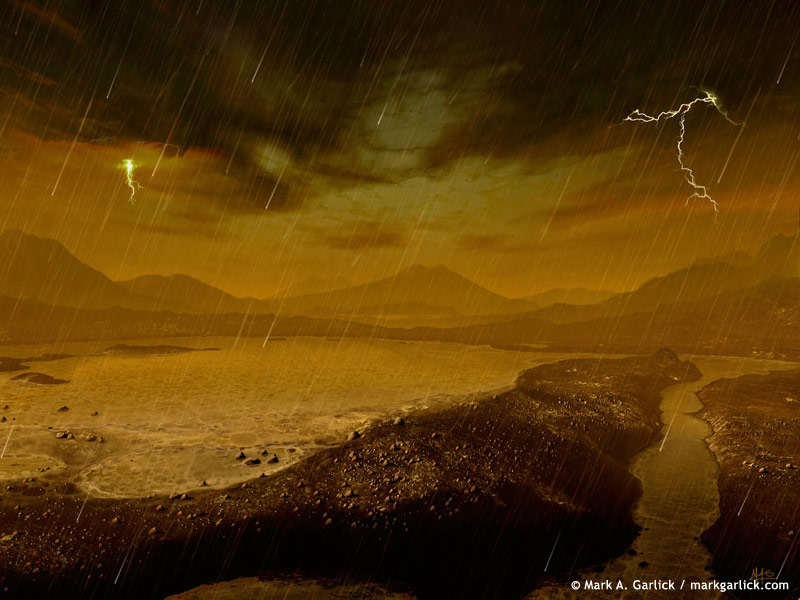
___________________________________________________________________
kad ce mostar mama?
Explanation: Is this our Sun? Yes. Even on a normal day, our Sun is sizzling ball of seething hot gas. Unpredictably, regions of strong and tangled magnetic fields arise, causing sunspots and bright active regions. The Sun's surface bubbles as hot hydrogen gas streams along looping magnetic fields. These active regions channel gas along magnetic loops, usually falling back but sometimes escaping into the solar corona or out into space as the solar wind. Pictured above is our Sun in three colors of ultraviolet light. Since only active regions emit significant amounts of energetic ultraviolet light, most of the Sun appears dark. The colorful portions glow spectacularly, pinpointing the Sun's hottest and most violent regions. Although the Sun is constantly changing, the rate of visible light it emits has been relatively stable over the past five billion years, allowing life to emerge on Earth.

___________________________________________________________________
kad ce mostar mama?
Explanation: Binary star system GRO J1655-40 consists of a relatively normal star about twice as massive as the Sun co-orbiting with a black hole of about seven solar masses. This striking artist's vision of the exotic binary system helps visualize matter drawn from the normal star by gravity and swirling toward the black hole. But it also includes a wind of material escaping from the black hole's accretion disk. In fact, astronomers now argue that Chandra Observatory x-ray data indicate a high-speed wind is being driven from this system's disk by magnetic forces. Internal magnetic fields also help drive material in the swirling disk into the black hole itself. If you had x-ray eyes as good as Chandra's, you could find GRO J1655-40 about 11,000 light-years away in the constellation Scorpius.

___________________________________________________________________
kad ce mostar mama?
Explanation: This fantastic skyscape lies at the eastern edge of giant stellar nursery W5, about 7,000 light-years away in the constellation Cassiopeia. An infrared view from the Spitzer Space Telescope, it features interstellar clouds of cold gas and dust sculpted by winds and radiation from a hot, massive star outside the picture (just above and to the right). Still swaddled within the cosmic clouds, newborn stars are revealed by Spitzer's penetrating gaze, their formation also triggered by the massive star. Fittingly dubbed "Mountains of Creation", these interstellar clouds are about 10 times the size of the analogous Pillars of Creation in M16, made famous in a 1995 Hubble Space Telescope view. W5 is also known as IC 1848 and together with IC 1805 it is part of a complex region popularly dubbed the Heart and Soul Nebulae. The Spitzer image spans about 70 light-years at the distance of W5.
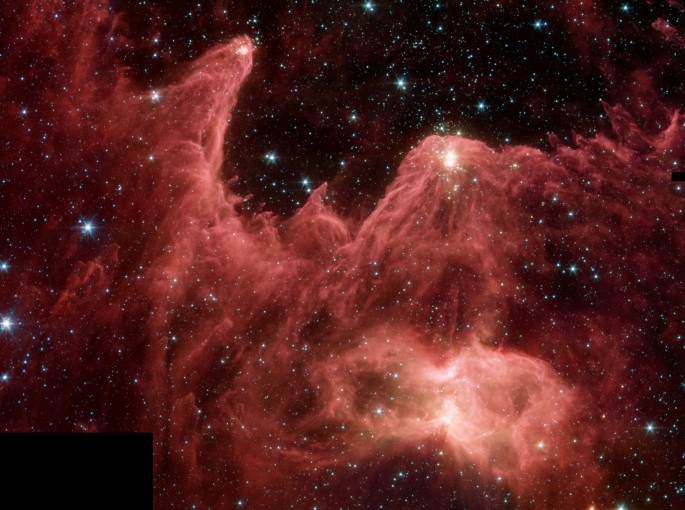
___________________________________________________________________
kad ce mostar mama?
Explanation: This strange, false-color image of otherwise familiar planet Saturn shows temperature changes based on thermal infrared emission in the gas giant's atmosphere and rings. Recorded from the Keck I telescope on Mauna Kea, the sharp, ground-based picture of Saturn's southern hemisphere is a mosaic of 35 images. Based on the effects of sunlight during the southern summer season, general warming trends were anticipated. But a surprising result of the infrared image data is the a clear indication of an abruptly warmer polar cap and bright hot spot at Saturn's south pole. The warm south pole and hot spot may be unique in the solar system and a further exploration of the region is planned using instruments on the Cassini spacecraft. So how hot is Saturn's hot spot? The upper tropospheric temperature is a sweltering 91 Kelvin (-296 degrees Fahrenheit) at the pole.

___________________________________________________________________
kad ce mostar mama?
Explanation: Jupiter's Great Red Spot is a swirling storm seen for over 300 years, since the beginning of telescopic observations. But in February 2006, planetary imager Christopher Go noticed it had been joined by Red Spot Jr - formed as smaller whitish oval-shaped storms merged and then developed the remarkable reddish hue. This sharp Hubble Space Telescope image showing the two salmon-colored Jovian storms was recorded in April. About half the size of the original Red Spot, Red Spot Jr. is similar in diameter to planet Earth. Seen here below and left of the ancient storm system, it trails the Great Red Spot by about an hour as the planet rotates from left to right. While astronomers still don't exactly understand why Jupiter's red spots are red, they do think the appearance of Red Spot Jr. provides evidence for climate change on the Solar System's ruling gas giant.
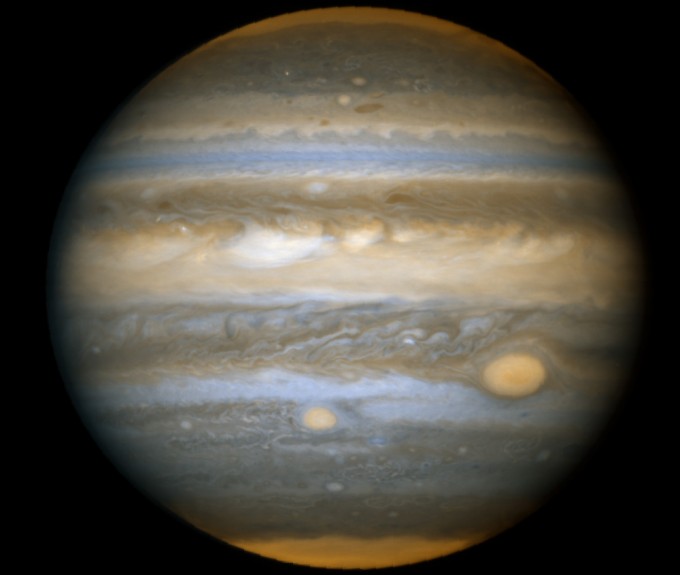
___________________________________________________________________
kad ce mostar mama?
ova je najbolja :)
zove se "water on mars" 
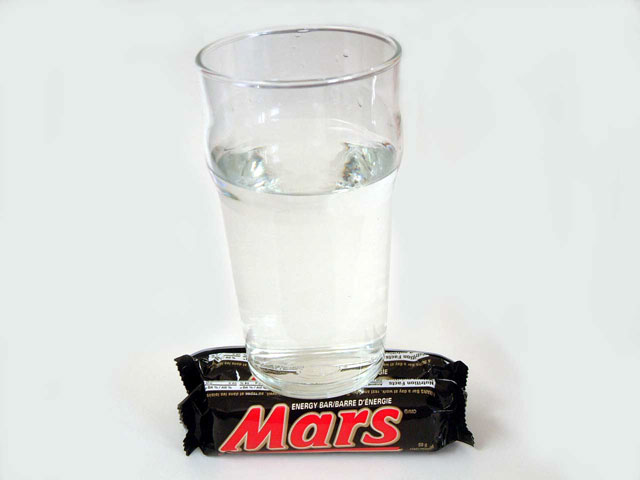
___________________________________________________________________
kad ce mostar mama?
pa ko moze vaku ljepotu da napravi?
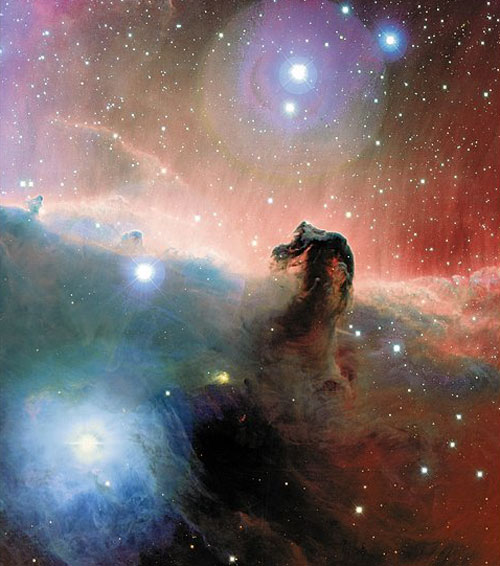
Explanation: While drifting through the cosmos, a magnificent interstellar dust cloud became sculpted by stellar winds and radiation to assume a recognizable shape. Fittingly named the Horsehead Nebula, it is embedded in the vast and complex Orion Nebula. The dark molecular cloud, roughly 1,500 light years distant, is cataloged as Barnard 33 and is visible only because its obscuring dust is silhouetted against the bright emission nebula IC 434. The bright blue reflection nebula NGC 2023 is visible on the lower left. The prominent horse head portion of the nebula is really just part of a larger cloud of dust which can be seen extending toward the bottom of the picture. A potentially rewarding but difficult object to view with a small telescope, this gorgeous representative-color image was taken by the large 3.6-m Canada-France-Hawaii Telescope in Hawaii, USA.
___________________________________________________________________
kad ce mostar mama?
fantasticno samo ali previse fantazije tana 
nije ovo fantazija burazeru ovo su stvarne fotografije 
___________________________________________________________________
kad ce mostar mama?
Nema Sanse nevjerujem 
istina ziva, provjeri njihovu stranicu.
sve su ovo stvarne fotografije kosmosa.
neke od njih su bazirane na gama zrakama ili x zrakama ali ipak su fotografije
golemo jelde?
___________________________________________________________________
kad ce mostar mama?
predivno, vrjedi pogledati i dobro razmisliti.
http://www.space.com/php/multimedia/imagegallery/igviewer.php?imgid=1569&gid=130
___________________________________________________________________
-Ja se ne slažem niti s jednom rijeèi koju si izgovorio, ali æu uvjek braniti tvoje pravo da ih izgovoriš.
kompozitne fotografije...sa dodatom bojom...(iako gasovi emituju boje...boja je dodata...)...citat od tana:
nije ovo fantazija burazeru ovo su stvarne fotografije 
Jedna od najjebenijih meni je snimka nebule-EYE OF THE GOD....od prije par godina..
___________________________________________________________________
I am sick,demented,perverted,arogant,sarcastic egomaniac and I am a living god ..
Sha-Shi is my name..and off course,I do piss excellence in the morning..
mislis ova?

___________________________________________________________________
kad ce mostar mama?
Makinja od strane: Burning Board 2.0.2 © 2001/2002 WoltLab GbR
Prevod sa engleskog T&T.